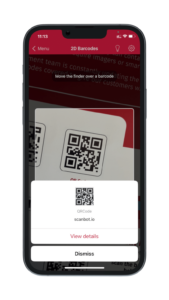In recent decades, the industrial sector has been massively influenced by digitization trends that have led to ever more streamlined manufacturing processes. Much of this is due to artificial intelligence and machine-learning-enabled digital networks that connect data, processes, people, services, and systems. To ensure well-coordinated, friction-free production processes and reduce costs, manufacturers have to streamline every part of their value chains. In particular, they must ensure flawless communication channels between customers, suppliers, and internal department interfaces. As they can connect digital data and physical objects efficiently and accurately, barcodes enable the seamless integration of any item into such a system.
Why is it so important for manufacturers to implement a barcode system?
Real-time data exchange is a cornerstone of a thoroughly optimized manufacturing process, as it turns products and equipment into parts of the system. Reliable information on them needs to be available at any point in the production and distribution processes, because every error translates into losses in quality, productivity, and revenue generated.
Yet the full potential of digital technology is still rarely applied to all areas within the complex ecosystems of a modern factory. Countless manufacturers still rely on manual data entry. The processes affected are thus prone to human error, resulting in friction between the interdependent links of the different value chains. Frictions in production have consequences no manufacturer wants to face: lost productivity and higher avoidable expenditures. As IBM reports that poor data quality, in particular, costs the average business almost $10 million annually, manufacturing businesses clearly need to avoid these error-prone processes at all costs.
Companies need to rationalize each step within their production to exploit their factories’ full potential and maximize revenue. Implementing a barcode system for this purpose takes just a few simple steps. By doing so, you quickly enable employees to precisely track every item’s location or quantity across any point in the production chain with just one quick scan.

Extract 1D and 2D barcodes in milliseconds
Automating ineffcient and time-consuming workflows boosts productivity and reduces costs.
Barcodes make the transition seamless and can be scanned by any mobile device with a camera and the right software.
Our Barcode Scanner SDK can be integrated into your mobile or web app in just a few hours to transform any mobile device into a powerful barcode scanner!
Step by step: How to implement a barcode system in manufacturing
Let’s now take a look at the crucial steps involved in rolling out a barcode system in manufacturing.
Step 1: Create barcode labels
To design a barcoding system, of course, you will first need barcode labels to attach to materials and finished goods throughout the manufacturing process. For this, you will need to determine what data you’d like to store and pick a barcode standard that suits your requirements.
Step 2: Align the process with your software system
Employees can now quickly scan the attached barcodes using either conventional hardware scanners or budget mobile devices, such as smartphones or tablets.
Note: Using smartphones as portable scanners has significant advantages over standard scanners. You can discover more on this in our eBook on Smart Factories.
Whether you opt for conventional hardware or for smartphones running a Barcode Scanner SDK, either must be integrated seamlessly into your existing software ecosystem. This guarantees a frictionless data transfer between the scanning devices and the used software, such as your ERP or CMMS.
Step 3: Establish the entire barcoding process
Before rolling out your new system, you should have all involved processes already tested and in place. This includes the application of the labels, updating information in the software system, and the scanning process itself. For example, carefully consider where to place the barcode label on each item to ensure that it is not easily obscured.
Step 4: Roll out the new system step-by-step
Most manufacturers ultimately desire to optimize their whole production process using a barcode system – from receiving raw materials to packing the final goods. Tackling all these areas at once is quite challenging, however. If not executed properly, such a project might even increase friction rather than reduce it.
It is best to start small, for instance by applying those changes to either raw materials or finished goods first. This way, initial difficulties and the resulting changes to the system won’t affect the whole production chain, but just a segment of it.
Note: To barcode raw materials, it can be helpful to align the used symbologies with your suppliers. As barcoding in manufacturing has become common practice, this is now just another standard operating procedure for most suppliers.
With proper planning, manufacturers can add significant value to the production process by implementing a barcode system. Reducing manual data entry by automating critical steps in the manufacturing process results in a considerable ROI and future-proof workflows.
How your manufacturing business can benefit from using smartphones as barcode scanners
Smartphones offer numerous advantages for barcode scanning in factories. Here, we have collected the most relevant ones for you:
Direct availability of information: Employees can access all relevant information related to a specific product directly on the device – no computers or other hardware necessary. Tracking items, gaining insight into stock levels, or finding the right equipment becomes as easy as pie.
Total Cost of Ownership (TCO): Budget smartphones with a long battery life and suitable camera resolution are available for just around $300. Scanning devices with comparable accuracy and speed typically cost twice as much to acquire. Additionally, those devices need far more maintenance than smartphones or tablets.
Ease-of-use: Today, almost everyone owns a smartphone. Thus, employees do not need to learn to handle those devices before using them. Compared to dedicated scanners, easy-to-use mobile scanning capabilities on smart devices reduce onboarding time enormously.
Versatility: Standard laser scanners are only suitable for 1D barcodes. 2D symbologies such as the common QR code, on the other hand, require dedicated and costly imager scanners. Modern smartphones are the cheapest way to tackle both types of codes.
